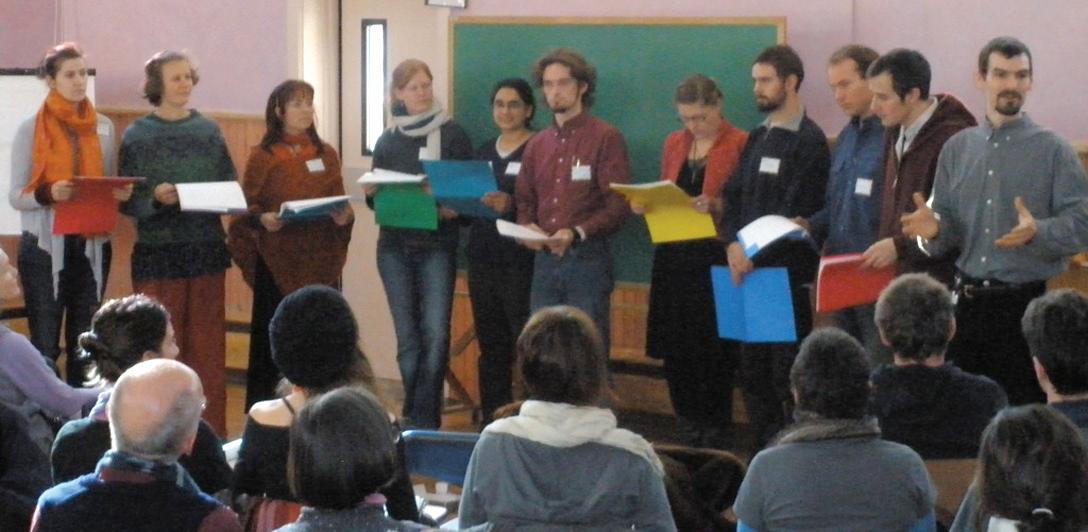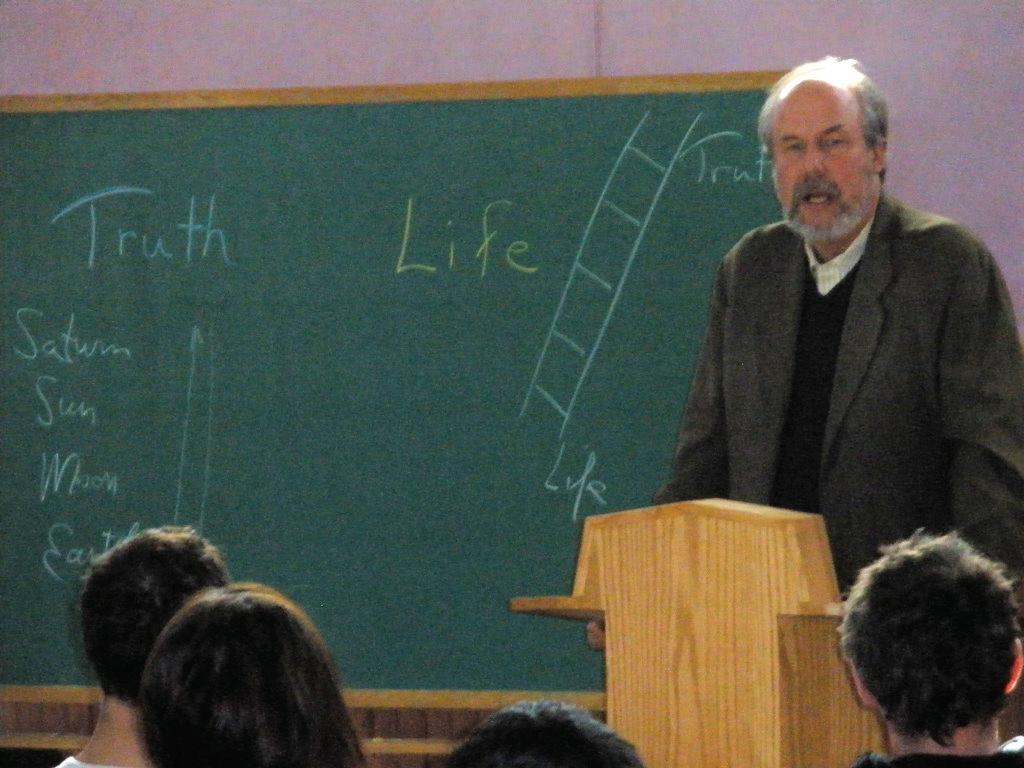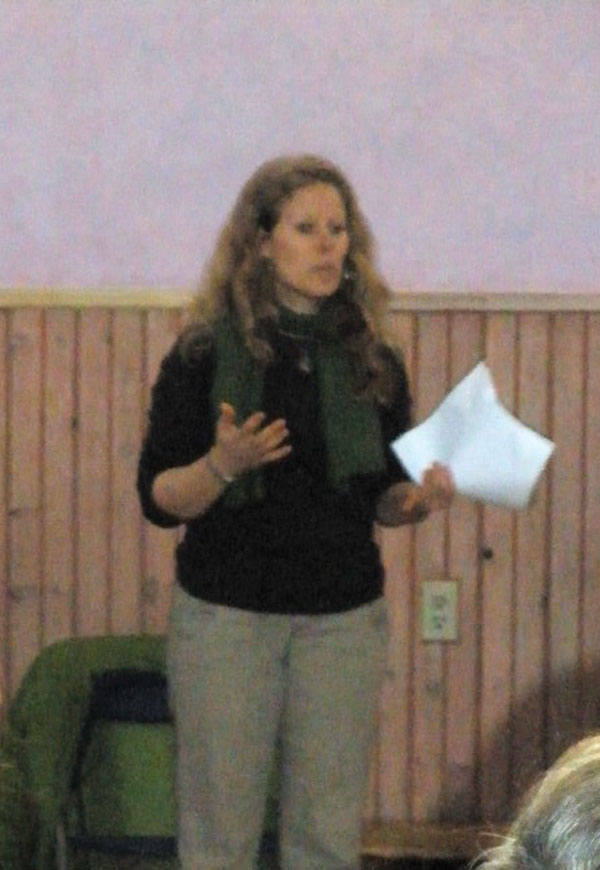
14 minute read
The Task of the Anthroposophical Society in This Century
“An overview of how the big picture was wrestled with during a day-long workshop”
from Chanticleer, the Berkshire-Taconic Branch newsletter, Feb. 2010
On January 16, 2010 approximately 60 people gathered together in the Hawthorne Valley School‘s assembly hall to tackle the question of what the meaning and task of the Anthroposophical Society is in this decade old century of ours.
After the briefest of introductions a smaller group, mainly participants from Think OutWord and the Youth Section, stepped forward to sing a well-crafted suite of mostly shaped-note hymns. Aside from the beneficial listening mood evoked by this lovely, spiritually inclined music, a few telling words and phrases from the hymns set the tone for the day. “Wrestling soul,” “fear,” “death,” “eternal harmony,” were audible examples from the sung lyrics.

Think OutWord and Youth Section members lead off with singing...
Torin Finser then approached the podium, but he didn‘t stay there very long. Almost immediately he put everyone to work. He got the conferees to break up into constellations of five. Against the backdrop of an imagined grim future when all outer manifestations of anthroposophy would be gone from the face of the earth, each participant had to identify their most cherished “inner” treasure from Steiner‘s work.
After a few intensive minutes conversing about this thought-provoking question, Torin was up again, herding all present into a new configuration. This time an inner circle of twelve chairs, of which nine were occupied by volunteer conversationalists, was surrounded by a larger circle of silent listeners. Those within were mandated to converse on the question, “How do you know that something is really true?” As the conversation evolved, “outsiders” moved in and “insiders” moved out. Those who changed position did so at their discretion.
Only after that existential question was addressed and carried for a good while did we “revert” to the classic form of a keynote address. All chairs were slid back to their traditional positions in podium-facing rows, which is what you would expect at the beginning of such a weighty conference. Torin then spoke on the polarity of Truth and Life, from their Apollonian and Dionysian aspects respectively. Torin chose a pregnant quote from the third letter to the members to bracket and to be the basis of his talk: “In anthroposophy it is the Truths it can reveal which matter: in the Anthroposophical Society it is the Life that is cultivated.” [In The Life, Nature & Cultivation of Anthroposophy, GA26.] He spoke in his role as the U. S. Society‘s General Secretary, so he was able to weave into his presentation the perspectives he had gained from attending the General Secretaries Conference in Dornach, where the Society’s task in the 21st century is an important question. [Nathaniel Williams’ report on Torin’s talk follows.]

Gary Lamb speaks to the group
After lunch, everyone sang. Then Rachel Schwartz rendered a passionate, heartfelt, thoughtful presentation on the 1923-1924 Christmas Conference and its significance for the society‘s future. [A report by Peter Buckbee follows.] There could be no doubt in the mind of any listener who was awake during this talk that Rachel is absolutely convinced that the future of the society lies in the members working together actively out of that impulse. For her, the conference lives on, as does the need to build that indestructible, spiritual Goetheanum under which Steiner laid the Foundation Stone, as well as the need to reach out to as many young people as possible to alert them of this central task.
Before the closing singing, there was still time to open it up to a conversation. And converse everyone did, in a notably frank and honest manner. An intense sequence of contributions sounded into the auditorium, and it brought to the surface the anguish, hope, despair, and goodwill that lived among those gathered. There is certainly much concentrated feeling and thinking within many individuals when contemplating the upcoming task of the society. At the same time, it is fair to say that no one in the room was expecting that the question of what the society was supposed to be doing for the next ninety years was going to be solved then and there, once and for all.
Just prior to the concluding conversation all of the participants were asked to write down their thoughts on the meaning and task of the Anthroposophical Society at that moment.
From one perspective, the gathering itself, in its makeup and expression, may be a clue to the society‘s future. Close to half of those present were under forty, and out of that half a goodly portion was under thirty. The conference began, as mentioned, not with a keynote address, but with small groups wherein individuals conversed about and listened intensely to something that came from the heart of each one there.
Report on Torin Finser’s talk, by Nathaniel Williams
After leading the greater group in some conversation Torin Finser focused in on one theme to pursue in depth. He gave a presentation focusing on Truth and Life where he began with a statement from Rudolf Steiner’s third letter to the members.
He then continued by guiding our gaze back over the centuries into old Greece. There the mysteries of Apollo and of Dionysus appear.
Apollo who “spoke to men by Zeus’s decree, and for whom no shadow blurred the truth.” Scores of people found their way to the oracle at Delphi, to Apollo who emanated purification. His face was not only pure, though; he also had a face which was pitiless, was cruel.

Nathaniel Williams
Students of the Apollonian mysteries were directed to look out into the great expanses of nature for enlightenment. In doing this they became detached from themselves, they were in danger of flying out, without any roots, into the world around them. This loss of anchor ignited fear in them. They were instructed to transform this fear into awe and reverence in order to maintain themselves. This was a process of catharsis.
Dionysus brings the culture of the vine to people. He is said to have defied death, and death submitted. We find in him the power of resurrection. He could be kind, but he could also be terribly cruel. His power was of ecstatic joy, freedom on one side and brutality on the other. Cicero gave beautiful expression to his attitude in life by saying “Live with joy, die with hope.” Those on the path of Dionysian mysteries were called to know themselves, and their introspection made them vulnerable to the most extreme egotism. They were encouraged to seek balance to this through cultivating compassion. Christopher Bamford has given this cultivation beautiful expression in An Endless Trace:
The eloquence of this expression is akin to what we find in Cicero. Today, long after Greek times we need both reverence and compassion for the difficulties we face.
Mr. Finser went on by pointing to Truth and Life as expressions of these powers in our time. He brought forward statements out of the letters to the members where he found emphasis on these two powers. First he brought forth a few indicating the power of truth.
» In the first letter the view of looking to the work coming from the Goetheanum as witness of truth.
» In letter five there is an encouragement to work toward common consciousness.
» In letter six the need of members to understand each other is stated.
» In letter seven anthroposophy is described as leading to a wider awakening in the beauty, greatness and the sublimity of nature.
» In letter ten the condition of forming pictures of anthroposophical truths is articulated. It is a condition that each picture must be permeated with reverence.
Torin Finser also brought indications of life out of the letters.
» In letter one we find the instruction that those who would wish to have anthroposophy as a living part of their lives should join the society.
» In letter six the observation is made that in the society individuals draw closer together than in any other field.
» In the seventh letter one finds the observation that in the heart there lives the longing for full and complete life.
Mr. Finser pointed out that besides branch work as a place where individuals draw closer together and find their way into the deeper parts of life, there should be special subject groups of all kinds. This is an area which has tremendous possibility. Rudolf Steiner had encouraged this and used the example of instrument builders. People have a longing in their hearts to go beyond daily routine, to have a full and complete life.
We find a unity of these two forces of truth and of life in anthroposophy and in the verse by Rudolf Steiner:
Through working together, through the spoken word we come closer together. Through the work we grow into a wider perspective, and love develops. One should sense when coming together with others—
Here we are coming to see the interaction between the two forces. If you see truth on one side of a ladder and life on another you can see that something weaves in between the two. Any truth that we grasp in turn flows down into our action and life. A life experience that we pass through in an engaged and creative way leads us to insight and truth.

Torin Finser
One can also look at this from the perspective of evolution.
Saturn — Warmth, life in the bosom of God, in the womb
Sun — Air, truth
Moon — Water, soul life
Earth — Physical
The tasks of the anthroposophical society demand movement between these areas, breathing from one into the other.
Torin Finser then pointed out that if you looked at the past fifty years of the society and thought of these two powers as on a scale, you would see that truth has been laid on far heavier than life. If truth is overemphasized then you forget life. He pointed to the fact that the meetings of the General Secretaries are revealing more and more the need to cultivate life.
The truth needs life, the life needs the truth. The kings need the shepherds the shepherds the Kings. The General Anthroposophical Society needs the School for Spiritual Science and the School for Spiritual Science needs the General Society.
Torin Finser then went on to describe eight points that have been developed in the General Secretary meetings.
1. There is a need for information. A society is a worldwide movement and must be able to communicate.
2. A living festival life needs to be cultivated.
3. There is a need to continually support freedom. How can this be done while avoiding the negative associations this word has gathered in our time through politics.
4. Confidence and Trust need to be developed. This means having trust precisely when I am not involved, when I am not responsible.
5. The quality of meetings needs to be very high. They need to be spaces where destiny can work. They need to be inviting. This is greatly supported through the practice and presence of art.
6. Society leaders need to see themselves as serving humanity not just the society.
7. There is a need to create a culture of peace. Inner battles must be fought. The culture of peace is connected to silence.
8. We need to develop a readiness to go to the edge, to work with threshold experiences. This should be present in our celebration of birth and our work with the passing at death. The greater world will find itself with the question, how is this possible, how can this be done? The answer is anthroposophy.
This can be difficult but it is necessary. Humor can be an aid. Torin Finser described trying to accompany a close friend of his through death and yet feeling unable to speak of it. With the friend quoting Walter Johannes Stein this all changed. She said, “You know Torin, you have told me before, there is the time of your birth, the time of your death and in between you have the time of your life.”
Today we find there is a fear of the spiritual. Today people only see the spiritual as religious and that is thought of as equivalent to dogmatic. Today we need to find our way to celebrate truth by working into life. Anthroposophists should find the courage to speak clearly and openly. The 21st century is not a century for shyness.
We have 48,000 members of the society worldwide. Last year the membership grew in the USA. There are eight million connected with anthroposophical work in some way. We need to pull together, to become a strong movement. Mr. Finser read the quote from Rudolf Steiner which he had begun with to close.
Report on Rachel Schwartz’s talk, by Peter Buckbee
On the 16th of January, 2010, as a part of the “The Meaning and Task of the Anthroposophical Society in the 21st Century” gathering in Harlemville NY, Rachel Schwartz gave a presentation on the refounding of the anthroposophical society in 1923 during the Christmas Conference. Rachel described in a heartfelt way her path of discovery, as it lead her first to the Anthroposophical Society, then eventually deeper into what took place at the Christmas Conference. Below are some of the thoughts she shared.

Rachel Schwartz
The Christmas Conference is something that can be experienced as both a personal and a cosmic event. It could be seen as a refounding of the mysteries and a path of initiation for our time. It was a Michaelic deed that spoke to the hearts of the members who were present, and at the same time to the whole earth and heavens. It was at that time that Rudolf Steiner took on leadership of the Society, thus uniting his karma with it. In that sense, every failure on our behalf is an obstacle also for him, and “every success can become a building stone in the new temple, the invisible temple of human community.”
Rachel conveyed how, when her parents were young, the Christmas conference was still very much living in anthroposophical circles and could be met as a “sea of esotericism.” The Christmas Conference is never closed, but how is it living now? It’s there for spiritual beings and also for human beings who are called to work together. Yet, where are the other young people who feel the draw to this substance and to do this kind of work? Have we been hindered by materialistic thinking? It’s crucial that people share their spiritual experiences with one another. The anthroposophical society should be a place for openness, and also for genuine esotericism. She reminded us of the first statute: “[The purpose of the anthroposophical society is] to nurture the life of the soul on the basis of true knowledge of spiritual science.” Truth and Life cannot be separated. Truth is in service to life, life in service to truth. It’s a natural urge to want to be of aid to the world, and the anthroposophical society ideally is a place where we find nourishment through a sharing of truth and life so that we can better serve the world while living out our destiny.
This path involves ceaseless commitment to cultivating the inner life, through working with the Foundation Stone meditation, for instance. This simple inner act holds so much power that if taken seriously by enough people, over time it will solve world problems. This takes courage; “courage will make us wakeful.” Rachel ended with a poem by Rex Raab on Membership.
Thanks to Gary Lamb who organized these reports, to the reporters, and to Kristin Ramsden for the photos. —The editor.










